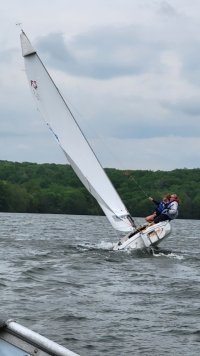klb67pgh
Member III
My wife is a high school physics, earth science, and other assorted science classes teacher. Her senior physics class students know we have an Ericson 25 and have asked about sailing. My wife decided to give them a day on the water towards the end of the school year. They did some class work on what makes a sailboat go, true and apparent wind, a few vector problems, etc., and today was our day on the water. Our sailing club owns several Flying Scots (and Sunfish, and Hobies). I'm a U.S. Sailing instructor and agreed to do the crash course chalk talk on sailboat and sail parts, points of sail, right of way rules, tacking, how to get out of irons, etc. We launched 3 FS boats and walked through rigging the boats at the dock. I lined up 3 of our good FS sailors and instructors to take 2 or 3 kids out in each boat and off they went. Most students got some tiller time. Unfortunately our great wind and 0% chance of rain forecast turned into a cold steady rain by late morning and we were chased of the lake for an early lunch inside the race garage with several kids finding blankets and towels to try to dry off and try to warm up. A few hearty souls wanted to go back out after lunch and I managed to get a few pics - the captain definitely hauled in the mainsheet for the last photo.  The kids had a great day despite the weather, we had a good lunch discussion about their on the water experience, the next phase of school/life, and great advice from an engineer/sailing instructor on a career in science related fields (his team builds moon landers), and we did some knot tying too. Despite what you might perceive from traditional news sources, I don't think we are quite doomed yet with this generation. Sure they need to know where their phones are at all times, but they still ask insightful questions and some of them have a pretty good can-do attitude.
The kids had a great day despite the weather, we had a good lunch discussion about their on the water experience, the next phase of school/life, and great advice from an engineer/sailing instructor on a career in science related fields (his team builds moon landers), and we did some knot tying too. Despite what you might perceive from traditional news sources, I don't think we are quite doomed yet with this generation. Sure they need to know where their phones are at all times, but they still ask insightful questions and some of them have a pretty good can-do attitude.






